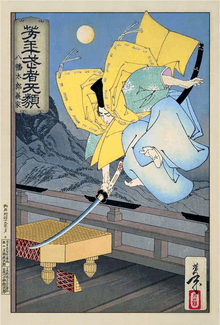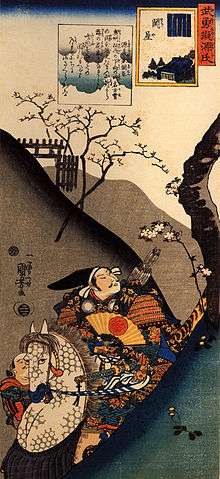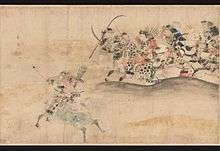Minamoto no Yoshiie
Minamoto No Yoshiie (源 義家; 1039 – 4 August 1106), also known as Hachimantarō, was a Minamoto clan samurai of the late Heian period, and Chinjufu-shōgun (Commander-in-chief of the defense of the North).

The first son of Minamoto no Yoriyoshi,[1] he proved himself in battle with the Abe clan in the Zenkunen War (Early Nine Years' War) and the Kiyohara clan in the Gosannen War (Later Three Years' War). Subsequently, he became something of a paragon of samurai skill and bravery.[2]
After his death, Yoshiie was elevated to Kami status: renamed "Hachimantaro", lit. "son of Hachiman", the Shinto god of war, and was made by the Minamoto Clan into their Patron Ancestral Kami.
The Zenkunen War

In 1050, Abe no Yoritoki wave the post of Chinjufu-shōgun, as the Abe clan had for many generations; he was the chief commander of the defense of northern Honshū against the native Ezo (Ainu) people. Effectively, however, Yoritoki commanded the entire region, denying the official Governor any true power. As a result, Yoshiie's father was appointed both chinjufu shōgun and governor, and Yoshiie traveled north with him to resolve the situation.
The campaign against the Abe clan lasted twelve years (nine, with three years truce). Yoshiie fought alongside his father in most if not every battle, including the Battle of Kawasaki and the Siege of Kuriyagawa. Abe no Yoritoki died in 1057, but his son Abe no Sadato took up command of his father's forces.
Yoriyoshi's first son, Hachimantarō, gave hot pursuit along the Koromo River and called out, 'Sir, you show your back to your enemy! Aren't you ashamed? Turn around a minute, I have something to tell you.' When Sadato turned around, Yoshiie said:
Koromo no tate wa hokorobinikeri ("Koromo Castle has been destroyed." or, alternatively, "The warps in your robe have come undone.")
Sadato relaxed his reins somewhat and, turning his helmeted head, followed that with:
toshi o heishi ito no midare no kurushisa ni ("Over the years its threads became tangled, and this pains me.")
Hearing this, Yoshiie put away the arrow he had readied to shoot, and returned to his camp. In the midst of such a savage battle, that was a gentlemanly thing to do.[3]
Yoshiie returned to Kyoto in early 1063 with the heads of Abe no Sadato and a number of others.[4]
As a result of his dramatic prowess in battle, he earned the name Hachimantaro, referring to him as the "son of Hachiman", the god of war.[5] The following year, Yoshiie took several followers of the Abe, who he had taken as captives, as attendants.
The Later Three Years' War

Over twenty years later, Yoshiie was the chief commander in another important conflict of the Heian period. Beginning in 1083, he battled the Kiyohara family, who had fought alongside him and his father against the Abe, but who had since proven themselves poor rulers of the northern provinces.[4]
Named Governor of Mutsu province in 1083, Yoshiie took it upon himself, without orders from the Imperial Court, to bring some peace and order to the region. A series of disputes between Kiyohara no Masahira, Narihira, and Iehira over leadership of the clan had turned to violence.
There emerged a series of battles and skirmishes between Yoshiie's forces and those of the various Kiyohara sub-factions. Everything came to a head in 1087, at the Kanazawa stockade. Yoshiie, along with his younger brother Minamoto no Yoshimitsu and Fujiwara Kiyohira, assaulted the position held by Kiyohara no Iehira and his uncle Kiyohara no Takahira. After many months of failed starts and skirmishes, the stockade was set aflame, and the Kiyohara defeated; Takahira and Iehira were killed. The Minamoto forces suffered great losses as well, and it is said that Yoshiie was an especially skilled leader, keeping morale up and preserving a degree of discipline among the warriors.
Later life
"Yoshiiye returned to Kyoto, where he and his comrades resumed their military posts in command of Palace Guards and the Sovereign's Escorts." The only drama occurred when his eldest son, Yoshichika was banished to Sanuki. Escaping to Izumo, Yoshichika started a revolt which was put down in 1108 by Taira general Masamori, father of Taira no Tadamori.[2]:254–255
Family
- Father: Minamoto no Yoriyoshi (源頼義, 988–1075)
- Mother: daughter of Taira no Naokata (平直方の娘)
- Wife: daughter of Fujiwara no Aritsuna (藤原有綱の娘)
- 3rd son: Minamoto no Yoshitada (源義忠, 1083–1109)
- Son: Minamoto no Yoshikuni (源義国, 1091–1155)
- Wife: daughter of Minamoto no Takanaga (源隆長の娘)
- 2nd son: Minamoto no Yoshichika (源義親, ?–1108)
- Unknown mother:
- 1st son: Minamoto no Yoshimune (源義宗, ?–?)
- 6th son: Minamoto no Yoshitoki (源義時, ?–?)
- 7th son: Minamoto no Yoshitaka (源義隆, ?–1160)
- Daughter: wife of Imperial Prince Sukehito (輔仁親王室), son of Emperor Go-Sanjo.
- Daughter: wife of Minamoto no Shigeto (源重遠室)
- Wife: daughter of Fujiwara no Aritsuna (藤原有綱の娘)
See also
| Wikimedia Commons has media related to Minamoto no Yoshiie. |
References
- Sato, Hiroaki (1995). Legends of the Samurai. Overlook Duckworth. pp. 74–75. ISBN 9781590207307.
- Sansom, George (1958). A history of Japan to 1334. Stanford University Press. pp. 249–251. ISBN 0804705232.
- Heian Period
- Turnbull, Stephen (1977). The Samurai, A Military History. MacMillan Publishing Co., Inc. p. 22-24. ISBN 0026205408.
- Turnbull, Stephen (1998). The Samurai Sourcebook. Cassell & Co. p. 199. ISBN 1854095234.